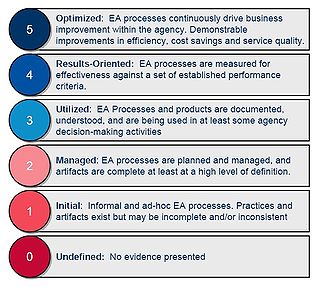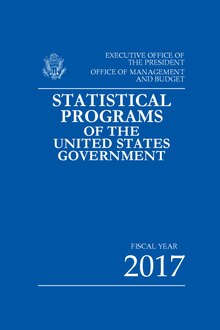
The Office of Management and Budget (OMB) is the largest office within the Executive Office of the President of the United States (EOP). OMB's most prominent function is to produce the president's budget, but it also examines agency programs, policies, and procedures to see whether they comply with the president's policies and coordinates inter-agency policy initiatives.
In the United States, a metropolitan statistical area (MSA) is a geographical region with a relatively high population density at its core and close economic ties throughout the region. Such regions are not legally incorporated as a city or town would be and are not legal administrative divisions like counties or separate entities such as states. As a result, sometimes the precise definition of a given metropolitan area will vary between sources. The statistical criteria for a standard metropolitan area were defined in 1949 and redefined as a metropolitan statistical area in 1983.

The Bureau of Intelligence and Research (INR) is an intelligence agency in the United States Department of State. Its central mission is to provide all-source intelligence and analysis in support of U.S. diplomacy and foreign policy. INR is the oldest civilian element of the U.S. Intelligence Community and among the smallest, with roughly 300 personnel. Though lacking the resources and technology of other U.S. intelligence agencies, it is "one of the most highly regarded" for the quality of its work.

The Federal Information Security Management Act of 2002 is a United States federal law enacted in 2002 as Title III of the E-Government Act of 2002. The act recognized the importance of information security to the economic and national security interests of the United States. The act requires each federal agency to develop, document, and implement an agency-wide program to provide information security for the information and information systems that support the operations and assets of the agency, including those provided or managed by another agency, contractor, or other source.
The Information Quality Act (IQA) or Data Quality Act (DQA), passed through the United States Congress in Section 515 of the Consolidated Appropriations Act, 2001. Because the Act was a two-sentence rider in a spending bill, it had no name given in the actual legislation. The Government Accountability Office uses the name "Information Quality Act".
A federal enterprise architecture framework (FEAF) is the U.S. reference enterprise architecture of a federal government. It provides a common approach for the integration of strategic, business and technology management as part of organization design and performance improvement.

The Philippine Statistics Authority is the central statistical authority of the Philippine government that collects, compiles, analyzes and publishes statistical information on economic, social, demographic, political affairs and general affairs of the people of the Philippines and enforces the civil registration functions in the country.
The Information Technology Management Reform Act of 1996 is a United States federal law, designed to improve the way the federal government acquires, uses and disposes information technology (IT). It was passed as Division E of the National Defense Authorization Act for Fiscal Year 1996. Together with the Federal Acquisition Reform Act of 1996, it is known as the Clinger–Cohen Act.
In the United States, federal assistance, also known as federal aid, federal benefits, or federal funds, is defined as any federal program, project, service, or activity provided by the federal government that directly assists domestic governments, organizations, or individuals in the areas of education, health, public safety, public welfare, and public works, among others.

In the United States, the Single Audit, Subpart F of the OMB Uniform Guidance, is a rigorous, organization-wide audit or examination of an entity that expends $750,000 or more of federal assistance received for its operations. Usually performed annually, the Single Audit's objective is to provide assurance to the US federal government as to the management and use of such funds by recipients such as states, cities, universities, non-profit organizations, and Indian Tribes. The audit is typically performed by an independent certified public accountant (CPA) and encompasses both financial and compliance components. The Single Audits must be submitted to the Federal Audit Clearinghouse along with a data collection form, Form SF-SAC.
In the United States, compliance requirements are a series of directives United States federal government agencies established that summarize hundreds of federal laws and regulations applicable to federal assistance. They are currently incorporated into the OMB A-133 Compliance Supplement, which was created by the US Office of Management and Budget (OMB).

The Budget and Accounting Act of 1921 was landmark legislation that established the framework for the modern federal budget. The act was approved by President Warren G. Harding to provide a national budget system and an independent audit of government accounts. The official title of this act is "The General Accounting Act of 1921", but is frequently referred to as "the budget act", or "the Budget and Accounting Act".

The Federal Geographic Data Committee (FGDC) is a United States government committee which promotes the coordinated development, use, sharing, and dissemination of geospatial data on a national basis. Its 32 members are representatives from the Executive Office of the President, and Cabinet level and independent federal agencies. The secretary of the Department of the Interior chairs the FGDC, with the deputy director for management, Office of Management and Budget (OMB) as vice-chair.

The Enterprise Architecture Assessment Framework (EAAF) was created by the US Federal government Office of Management and Budget (OMB) to allow federal agencies to assess and report their enterprise architecture activity and maturity, and advance the use of enterprise architecture in the federal government.

Katherine K. Wallman was an American statistician who served as the Chief Statistician of the United States from 1992 to 2017. In that role at the U.S. Office of Management and Budget, she provided coordination, guidance, and oversight for the Federal Statistical System of the United States. She died in January, 2024.

The Federal Information Technology Acquisition Reform Act made changes to the ways the U.S. federal government buys and manages computer technology. It became law as a part of the National Defense Authorization Act for Fiscal Year 2015 (Title VIII, Subtitle D, H.R. 3979.
The Chief Statistician of the United States is a position in the U.S. federal government's Office of Management and Budget (OMB). The Chief Statistician is charged with providing coordination, guidance, and oversight for U.S. federal statistical agencies and activities.

The Federal Risk and Authorization Management Program (FedRAMP) is a United States federal government-wide compliance program that provides a standardized approach to security assessment, authorization, and continuous monitoring for cloud products and services.

The Office of Federal Procurement Policy (OFPP) is a component of the United States Office of Management and Budget (OMB), which is part of the Executive Office of the President of the United States (EOP). OFPP provides overall direction for government-wide procurement procedures and "to promote economy, efficiency, and effectiveness in acquisition processes." OFPP is headed by an Administrator who is appointed by the President and confirmed by the Senate. In February 2018, President Donald Trump nominated Michael E. Wooten to be the next Administrator. Dr. Wooten was confirmed on August 1, 2019.




















